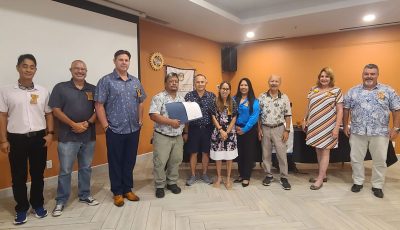DUE TO INSTALLATION OF NEW UNDERSEA CABLE
Sugar Dock to close partially
A portion of Sugar Dock and other public beaches in the CNMI would be temporarily closed for safety measures as Docomo Pacific lays down its new undersea fiber optic cable.
Claudine Camacho, environmental services chief of Duenas and Camacho Associates Inc., announced the partial closures during a public hearing on Docomo Pacific’s undersea fiber optic cable on Wednesday at the Bureau of Environmental and Coastal Quality conference room.
Called ATISA, it is set to become operational in May 2017.
Last year, the severance of IT&E’s fiber optic cable—the CNMI’s lone undersea cable—effectively disconnected the islands from the rest of the world as Internet and phone lines went down and put commerce at a standstill.
Docomo Pacific, owned by NTT Docomo Inc. of Japan, decided to place its own fiber optic cable along the main islands of Saipan, Rota and Tinian.
Camacho said in a presentation that Docomo’s cables would be apart from IT&E’s fiber optic cables “in order to minimize risks.”
“Should there be a natural phenomenon, we don’t want to have all our eggs in the same basket. Having that separation would minimize that risk. We were also looking to create as much separation to existing cables as possible,” said Camacho.
On Saipan, Chalan Kanoa’s Sugar Dock was chosen as the most viable spot on Saipan to lay the fiber optic cables.
“We’ve really explored all the feasible sites and we’ve really narrowed it down to a site in Chalan Kanoa, just south of the Aquarius Beach Tower Hotel,” said Camacho.
She said that no trees would be removed or mown down and that Sugar Dock has an area that “minimizes the impact on habitat.”
“This area is not within any land or sea preserved marine protected area, and there has been a thorough archaeological investigation of the area,” said Camacho.
“Several subsurface trenches were performed by Dr. Stephen Athens of the International Archaeological Research Institute of Hawaii. All the trenches did not yield any intact cultural deposits,” she added.
Camacho added that the fiber optic cable would be buried in the sand and that the project would take about a month per island.
“All the environmental protection measures would be present, to contain sediment within the work zone during construction, which would be estimated to take about a month for each site,” she said.
Docomo’s fiber optic site for Rota and Tinian would be at a beach southwest of Songsong village and the northern area of Tachogña Beach, respectively.
A portion of both beaches would be closed in order to accommodate the project, and like Saipan’s site, both sites do not require any removal of trees and have undergone archaeological investigations.
Docomo Pacific president and CEO Jonathan Kriegel was pleased with the hearing.
“I think we had a reasonably good turnout from the community. A variety of interests [were] represented—businesses, youth groups, and that was good. I thought it was a very constructive set of questions about the environment and the potential business impact, so all the questions were in fact constructive,” he said.



























